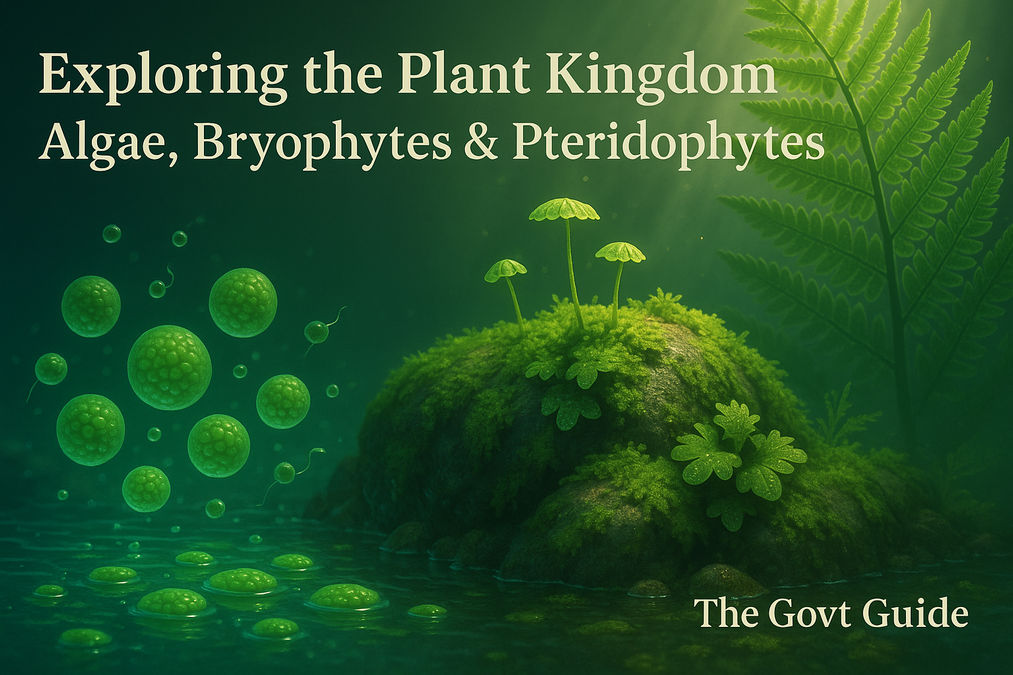Plant Kingdom Classification: From Algae to Pteridophytes

Algae: Nature’s Oxygen Factories
Algae are autotrophic organisms inhabiting diverse environments from oceans to tree bark. They contribute 50% of global oxygen and form the base of aquatic food chains.
Chlorophyceae (Green Algae)
- Habitat: Freshwater (e.g., Chlamydomonas), marine (e.g., Ulva)
- Pigments: Chlorophyll-a, b; starch storage
- Economic Use: Biofuel research (e.g., Chlorella)
Phaeophyceae (Brown Algae)
Example: Giant kelps (Macrocystis) form underwater forests. Algin from cell walls is used in ice cream stabilization.
Bryophytes: Earth’s First Land Plants
Mosses (e.g., Sphagnum) and liverworts (e.g., Marchantia) thrive in moist environments. Key roles include:
- Soil formation on rocks
- Water retention in peatlands
- Carbon sequestration
Life Cycle Breakdown
1. Gametophyte Dominance: Photosynthetic stage produces gametes.
2. Sporophyte Dependency: Zygote develops into capsule-bearing sporophyte.
3. Spore Dispersal: Wind spreads haploid spores for new colonies.
Pteridophytes: Evolution of Vascular Systems
Ferns (e.g., Dryopteris) and horsetails (e.g., Equisetum) marked a leap in plant evolution with:
- True roots and lignin-reinforced stems
- Microphylls vs. megaphylls leaf types
- Heterospory in Selaginella (precursor to seeds)
Frequently Asked Questions
Q: What distinguishes algae from bryophytes?
A: Algae are mostly aquatic, lack true tissues, and have a simple thallus body. Bryophytes are land plants with slightly differentiated structures (root-like rhizoids) but still require water for reproduction.
Q: Can algae survive in extreme environments?
A: Yes! Some algae thrive in hot springs (thermophiles) or icy habitats (psychrophiles). For example, Chlamydomonas nivalis grows on snow, giving it a red hue.
Q: How do pteridophytes differ from bryophytes?
A: Pteridophytes have vascular tissues (xylem/phloem) and true roots/stems/leaves, while bryophytes lack these. They also have a dominant sporophyte stage.
Q: Are all algae unicellular?
A: No. Algae can be unicellular (e.g., Chlamydomonas), colonial (e.g., Volvox), or multicellular (e.g., kelps like Laminaria).
Q: What are the economic uses of pteridophytes?
A: They are used medicinally (e.g., Dryopteris for worm treatment), as ornamental plants (ferns), and as soil binders to prevent erosion.
Q: Why are bryophytes ecologically significant?
A: They pioneer barren rocks, enabling soil formation. Sphagnum moss also acts as a carbon sink in peatlands, mitigating climate change.
Q: How do algae reproduce sexually?
A: Through fusion of gametes: isogamy (similar-sized gametes), anisogamy (unequal-sized), or oogamy (large non-motile egg + small motile sperm).
Q: Name common pteridophytes found in gardens.
A: Ferns like Adiantum (maidenhair fern) and Nephrolepis (sword fern) are popular for their lush foliage.
Q: Do bryophytes have vascular tissues?
A: No. Bryophytes rely on diffusion and capillary action for nutrient transport, which limits their size to small, moist habitats.
Q: How do pteridophytes benefit the environment?
A: They stabilize soil, improve water retention, and contribute to biodiversity by providing microhabitats for insects and microbes.
Join the conversation